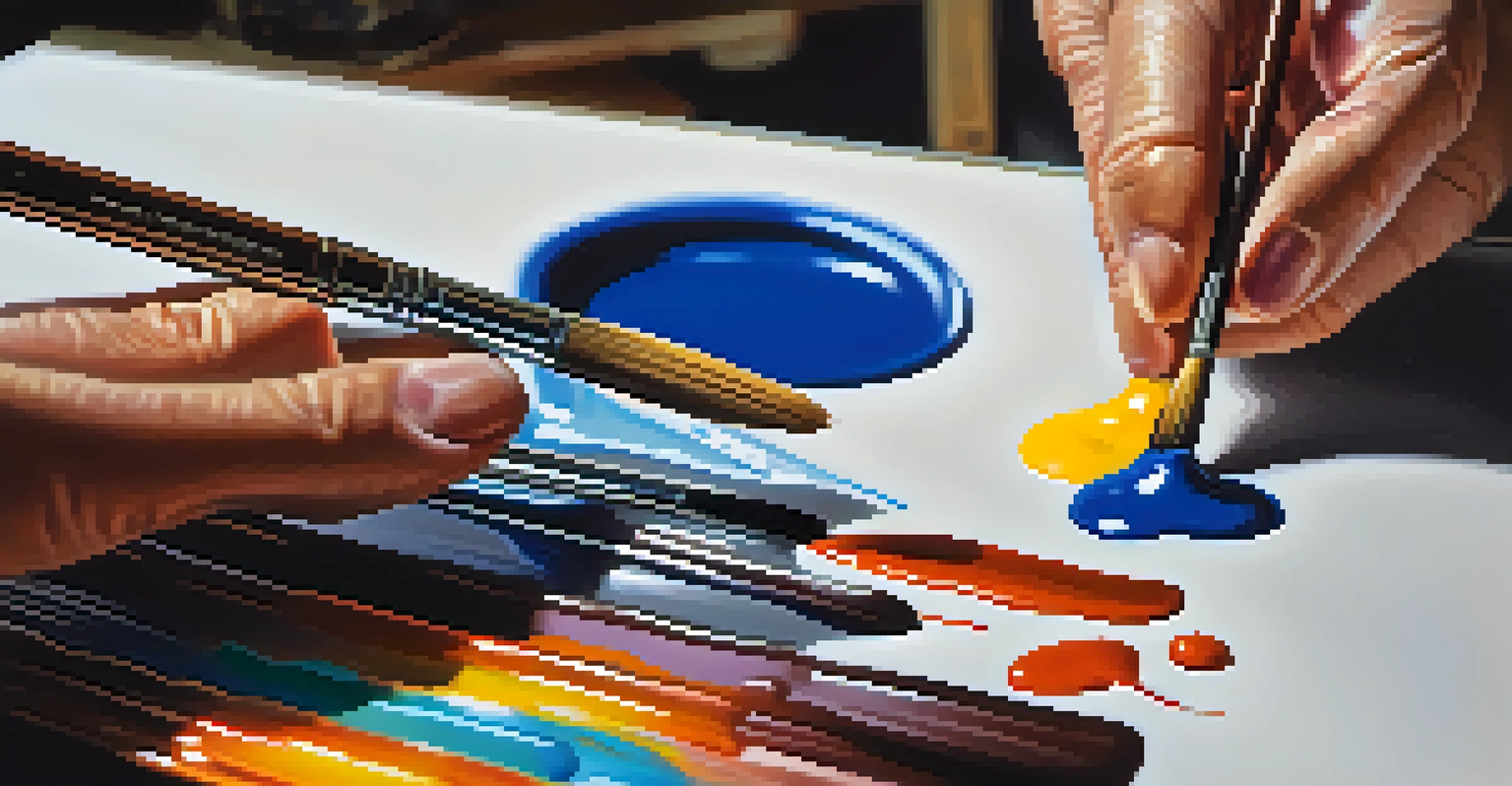Art Criticism: Evaluating Artworks with Insight and Depth

Understanding the Importance of Art Criticism
Art criticism serves as a bridge between the artist's intentions and the audience's interpretations. It helps viewers understand not just what they see, but also the context and emotions behind the artwork. By engaging with art criticism, we can appreciate the layers of meaning that might otherwise go unnoticed.
Art is not what you see, but what you make others see.
Furthermore, art criticism fosters a dialogue about art, encouraging diverse perspectives and interpretations. This exchange enriches our experience and understanding of the piece, making us more informed viewers. Just like a conversation at a dinner party, where everyone shares their thoughts, art criticism invites us to explore various viewpoints.
Related Resource
Ultimately, effective art criticism cultivates a deeper appreciation for art. It allows us to see beyond the surface and engage with the ideas and emotions that the artist wishes to convey. In this way, art criticism is not just an academic exercise; it's a way to connect more profoundly with the creative world.
The Role of Context in Art Evaluation
When evaluating an artwork, understanding its context is crucial. This includes the historical, cultural, and social backdrop against which the piece was created. For instance, a painting created during a time of political upheaval might carry different meanings than one made in a period of peace.

Context can also encompass the artist's background and influences. Knowing the artist's experiences, beliefs, and the movements they were part of can provide invaluable insight into their work. Just like knowing the backstory of a movie can enhance your viewing experience, understanding an artist's context deepens your appreciation of their art.
Art Criticism Enhances Appreciation
Engaging with art criticism deepens our understanding and appreciation of artworks by exploring their meanings and emotional contexts.
Moreover, art criticism benefits from acknowledging the audience’s context. Viewers bring their own backgrounds and experiences to their interpretations, which can lead to a rich tapestry of meanings. This interplay between the artist, their work, and the audience creates a dynamic environment for art evaluation.
Analyzing Form and Technique in Artworks
One of the most tangible aspects of art criticism is the analysis of form and technique. This includes examining the materials used, the composition, and the overall style of the artwork. For instance, the choice of colors, brush strokes, and textures can significantly impact the viewer's emotional response.
Every artist dips his brush in his own soul, and paints his own nature into his pictures.
In addition to materials, understanding the techniques employed by the artist can reveal their skill level and intentions. An intricate use of light and shadow, for example, can create depth and drama, drawing viewers into the scene. Just as a chef’s choice of ingredients can elevate a dish, an artist's techniques can transform a simple idea into a captivating experience.
Related Resource
Moreover, discussing form and technique allows critics to assess the effectiveness of the artwork in conveying its message. A piece that utilizes form in innovative ways can challenge traditional norms and provoke thought. This analysis not only highlights the artist's creativity but also encourages viewers to consider how technique influences their understanding of art.
Emotional Responses: Art's Impact on Viewers
Art has a powerful ability to evoke emotions, and this aspect is central to art criticism. Evaluating how a piece makes viewers feel can provide insight into its effectiveness and significance. Whether it sparks joy, sadness, or contemplation, these emotional responses are vital in understanding the artwork's impact.
Critics often explore the relationship between emotion and interpretation. For instance, a stark, monochromatic painting might elicit feelings of isolation or despair, while a vibrant, abstract piece could inspire excitement and wonder. Just as a piece of music can transport us to another place, art can trigger profound emotional journeys.
Context Shapes Art Interpretation
Understanding the historical, cultural, and personal context of an artwork enriches its interpretation and enhances viewer connection.
Ultimately, recognizing and articulating these emotional responses enriches the art criticism process. It invites viewers to reflect on their feelings and experiences, creating a personal connection to the art. This connection is what often makes art memorable, turning a simple viewing into a meaningful experience.
Engaging with Contemporary Art Criticism
Contemporary art criticism is an evolving field, reflecting changes in society and culture. Engaging with current critiques allows us to see how new ideas and movements are shaping the art world today. This is particularly important as artists increasingly challenge traditional boundaries and explore innovative mediums.
Moreover, contemporary criticism often emphasizes the role of technology and social media in art. Artists can now reach audiences directly, bypassing traditional gatekeepers. This shift has led to a democratization of art criticism, where anyone can contribute their thoughts and reactions online, much like a community discussion.
Related Resource
By engaging with contemporary criticism, we can better understand the ongoing conversations in the art world. This awareness fosters a more inclusive and informed appreciation of art, encouraging us to explore diverse voices and perspectives. Just as art itself evolves, so too does the discourse surrounding it, making it an exciting time to be an art enthusiast.
The Power of Personal Interpretation in Art
While art criticism often involves analysis and evaluation, personal interpretation plays a crucial role. Each viewer brings their own experiences, thoughts, and emotions to the artwork, resulting in unique understandings. This individuality enriches the overall conversation about art and its meanings.
For example, a landscape painting might remind one person of a cherished childhood memory while leaving another feeling indifferent. These varied interpretations highlight the subjective nature of art appreciation. Just as two friends can watch the same movie and come away with different impressions, art can resonate differently with each person.
Personal Interpretations Matter
Each viewer's unique experiences and emotions contribute to a diverse dialogue in art criticism, highlighting that there are no wrong interpretations.
Encouraging personal interpretation in art criticism promotes a more inclusive dialogue. It allows critics and viewers alike to share their insights, leading to deeper discussions about the artwork's significance. Ultimately, embracing personal interpretation fosters a richer appreciation of art, reminding us that there are no right or wrong ways to connect with it.
The Future of Art Criticism: Challenges and Opportunities
As the art world continues to evolve, so too does the field of art criticism. One of the primary challenges is keeping pace with rapid changes in technology and social media. Critics must adapt their approaches to engage audiences effectively in this digital age, where content is consumed differently than in the past.
However, this shift also presents opportunities for innovative criticism. The rise of online platforms allows for a broader range of voices to be heard, encouraging diverse perspectives and interpretations. Just as art itself reflects societal changes, art criticism can harness these trends to foster richer discussions about contemporary works.

Looking ahead, the future of art criticism will likely involve a blend of traditional evaluation methods and new, interactive approaches. This evolution can enhance our understanding of art, making it more accessible to a wider audience. As we embrace these changes, we can look forward to an exciting landscape of art criticism that continues to inspire and engage.